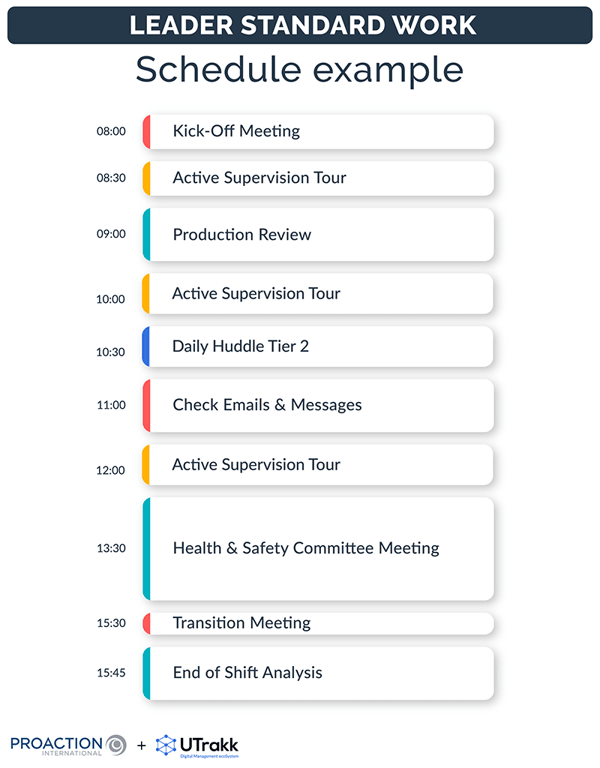What is Leader Standard Work and why it is important
Leader Standard Work refers to a set of structured routines and practices that managers at all levels perform on a recurring and consistent basis. In other words, it describes how standardized tasks are to be carried out in terms of cost, quality, delivery, and safety.
Through this standardized framework, team leaders are guided in their day-to-day responsibilities. They can focus on strategy development, critical tasks, and business priorities. Management standards provide the basis for effective leadership by consistently managing people, processes, and performance.

The leader's standardized work plays a vital role in several ways. It:
- Brings consistency to leadership practices: By establishing a set of routine activities that leaders follow, leader standard work ensures that all leaders consistently approach their responsibilities.
- Creates a stable and productive work environment: Predictable and reliable management actions provide a work environment where employees know what to expect and can focus effectively on their tasks, thereby improving overall productivity.
- Encourages interaction between team leaders and employees: LSW often includes scheduled times for leaders to engage with their teams, fostering open communication and stronger relationships, which are crucial for a collaborative work atmosphere.
- Promotes proactive control: By regularly monitoring and assessing key performance indicators, leaders can anticipate issues before they escalate, enabling more effective and proactive management.
- Improves team engagement and accountability: Leader Standard Work enhances workers' engagement through consistent leader-team interactions and clarifies roles and goals. It also promotes accountability by setting clear performance standards and responsibilities.
- Helps identify problems, bottlenecks, and opportunities for improvement: By systematically reviewing processes and outcomes, leaders are better positioned to spot inefficiencies, obstacles, and areas for improvement.
- Facilitates the sharing of proactive management practices within the company: Leader Standard Work creates a framework that can be shared and adopted throughout the organization, promoting a culture of proactive management and continuous improvement.
- Standardizes organization’s management processes: Consistent leadership practices and processes help maintain the quality and efficiency of operations.
- Streamlines new leaders onboarding: New leaders can adapt quickly and effectively by following established standard work practices, reducing the learning curve, and accelerating their integration into the organization.
- Contributes to developing management skills: Regularly engaging in standardized work allows leaders to continually practice and refine their skills, leading to personal and professional development.
Standard work applies to leaders at all organizational levels, from frontline managers to middle managers. It makes for more consistent, solid, and effective leadership.
The key processes of LSW
The key processes of Leader Standard Work typically include the following:

Proactive Gemba Walks
The team leader regularly goes out into the field, where value is created. He can do visual controls through recurring inspections and direct observation and interact directly with frontline workers. Based on a Japanese methodology that draws on Lean Manufacturing and Kaizen, Gemba Walks (or floor tours) are used by most global manufacturing leaders. It enables the manager to observe daily on-site operations, better understand the working environment, solve problems, and make informed decisions based on real-time information.
Standard meetings
Leader Standard Work includes structured, recurring meetings – daily production meetings, shift handovers, Short Interval Management, action follow-ups, management committees, EHS committees, improvement meetings, etc. – during which essential topics are discussed, information is shared, and every team member can express himself. These regular meetings help to establish more effective communication and collaborative efforts.
Audits and inspections
They enable managers to verify compliance and assess operational effectiveness. Audits are formal, periodic reviews of organizational practices against set standards (for example, a 5S audit), while inspections are routine checks to ensure ongoing adherence to these standards. They help managers identify and rectify deviations, improve processes, and make data-driven decisions.
Visual management
This essential element of Leader Standard Work uses visual cues and tools to streamline communication and effectively manage work practices.
Visual management tools, such as charts, graphs, and panels, are designed to make standardized work practices transparent and understandable, which provide a quick overview of processes and performance. Team leaders' regular performance indicators (KPIs) review enables them to track progress, identify trends, and make informed decisions based on measurable data. It keeps them informed of the organization's performance and enables timely corrective action to be taken if necessary.
Visual management also includes diagrams, images, and videos to guide employees in executing tasks, while Gemba Walks checklists ensure that regular site visits contribute to the continuous improvement of operations.
Procedures and training
Standard procedures and training in LSW provide a framework for performing tasks like safety protocols or quality control. These elements equip employees with the necessary skills and knowledge, ensuring operational consistency and efficiency. Managers use them to set performance standards, improve productivity, and drive continuous improvement, leading to a well-trained workforce and streamlined operations.
Personal development
Leader Standard Work also promotes continuous learning. Managers are encouraged to devote time to developing their skills, keeping abreast of trends in their industry, and working on themselves to shift their leadership mindset.
While these 7 management rituals are the most common, note that LSW can incorporate others depending on the leader's specific needs, objectives, organization, and sector. Overall, the primary focus is establishing a consistent routine that aligns with the company's reality and fosters a culture of continuous improvement.
6 Steps to define Leader Standard Work

1. Identify key leadership tasks
Leader Standard Work is tailored to each leadership level's specific needs and responsibilities, ensuring that leaders at all levels focus on the tasks most critical to their role and the organization's success.
- Team Leaders focus on operational tasks such as shift handoffs, problem-solving, and day-to-day management, spending approximately 80% of their time on these activities. Their LSW focuses on process confirmation, coaching, and direct team supervision.
- Middle managers spend about half their time on structured activities such as resource planning and aligning departmental goals with the organization’s strategy. Their LSW includes standardizing meetings, reporting, and following procedures.
- C-level executives focus on strategic tasks such as setting organizational goals, conducting high-level site visits to understand ground realities, and ensuring the organization complies with strategic standards.
2. Define standard procedures and work instructions
Once the strategic work tasks have been identified, develop Standard Operating Procedures (SOPs) that describe each task's specific steps, actions, and best practices. SOPs should be clear, concise, and easy to follow. They should guide how to carry out structured activities and describe any relevant documents, traditional tools, visual tools, measures, or resources that team leaders may need.
In addition to SOPs, detailed work instructions for all routine tasks are essential. These provide step-by-step guidance, including each activity's frequency, time spent, and expected outcome. Work instructions should also address common scenarios, potential challenges, and recommended problem-solving methodology.
3. Equip leaders with the right management tools
Equipping managers with the right management tools significantly improves their organizational and operational efficiency. It increases productivity, as managers can automate routine tasks, set reminders for critical actions, and track project progress. Communication is also enhanced thanks to features that facilitate sharing updates and feedback, improving teamwork. What's more, these tools provide analysis for data-driven decision-making.
4. Communicate and train management teams
Effective communication and training are essential to successfully implementing LSW. Communicate this method's purpose, benefits, and expectations to each organization's executive-level leaders. Everyone must understand why standardization is necessary and how it contributes to the company's success.
5. Establish key performance indicators
By defining performance indicators, managers can quantify their objectives and measure the effectiveness of standard procedures and processes. This quantitative approach enables regular assessment of the extent to which the team or organization achieves its objectives. When KPIs show deviations from desired results, managers can identify improvement areas and make the necessary adjustments.
6. Focus on continuous improvement
Standardized work should not be seen as a static set of instructions. Encourage managers to provide feedback, share ideas, and suggest improvements to existing procedures. Evaluate the effectiveness of LSW regularly and make any necessary adjustments as business needs evolve, management feedback is received, and the operating environment changes.
Pro tip: While leader’s standard work template is essential, leaving room for flexibility and adaptability is crucial. Team leaders need to be able to exercise their judgment, adapt their approach to the unique needs of their employees and situations, and make informed decisions in line with the organization's objectives. LSW should serve as a framework without becoming rigid rules.
How to digitalize Leader Standard Work with UTrakk
Using a digital tool like UTrakk Daily Management System (DMS) can significantly simplify the implementation and adoption of the Leader Standard Work. Our DMS helps structure management practices and routines through multiple functionalities that drive efficiency, problem-solving, and performance:
- Agenda: A digital agenda lets you plan and set standardized routines to guide your managers through their daily, weekly, and monthly tasks and activities – floor tours, daily huddles, production meetings, audits, inspections, performance reviews, etc. These recurring management activities help proactively identify variances, solve problems, assess and optimize processes, and capture performance data.
- Checklists: Standardized checklists can be associated with digital floor tours and audits planned in the agenda. A checklist includes questions and control points regarding cost, safety, quality, delivery, etc., enabling managers to make a rigorous and efficient assessment of these critical areas.
- Dashboards: User-friendly, personalized dashboards allow managers to visualize, track and analyze performance data. Dashboards in UTrakk are easy to share among team members and can be associated with standardized routines, which keeps everyone informed on trends, progress, and overall performance – on a regular basis.
- Knowledge Center: A centralized Knowledge Center provides managers with easy access to standardized documentation on operational processes and procedures (Standard Operating Procedures or SOPs), training, and best practices, ensuring clarity and compliance of work methods, as well as smooth onboarding for new team members.
To support LSW, UTrakk DMS also offers leadership development through coaching sessions, enabling managers and supervisors to monitor progression plans and measure management skills with key behavioral indicators (KBIs).
How coaching supports Leader Standard Work
Coaching plays a significant role in supporting, practicing, and improving Leader Standard Work. Here are the main areas in which structured coaching can help leaders adopt and implement this approach:
Provide a clear understanding of LSW
The coach helps leaders understand the expectations and objectives of the leader’s standard work. In particular, he will explain the purpose and benefits of this approach and guide leaders in identifying the specific tasks and behaviors that need to be integrated into their routines. This way, the coach provides leaders with a solid foundation for implementing standardized work.
Develop skills
The coach assesses leaders' current skills and identifies areas for improvement in standard work. Through individual coaching sessions, he can provide targeted training and development opportunities to improve leaders' skills in areas such as leading Gemba Walks, setting up effective meetings, routine and structured activities, analyzing performance measures, etc.
Give constructive feedback
By observing leaders in action, the coach can assess their management performance and provide constructive feedback. He can also offer reflection sessions, encouraging leaders to self-assess, identify strengths and weaknesses, and then draw up action plans for further improvements, thus promoting continuous improvement.
Follow up
The coach conducts regular checks and assesses progress to ensure leaders adhere to standard work practices. He also helps them identify obstacles and develop strategies to overcome them. By providing ongoing support and accountability, the coach helps keep leaders on track, makes them accountable, reinforces their experience, and maintains consistency in their standard work routines.
Coaching is a powerful tool for supporting and implementing LSW. With such support, they can continuously develop, adapt, and refine their management practices, resulting in improved performance, employee engagement, and organizational success.
Digitalized Leader Standard Work: A must for operational excellence
Leader Standard Work provides a framework for team leaders to excel in their management roles. By merging this approach with their day-to-day practices, they contribute to the maintenance and successful implementation of Lean Management. By introducing work procedures and structured routines that focus on strategic issues, employee engagement, problem-solving, and personal development, managers can create a culture of stability and continuous process improvement within the organization.
Regardless of the industry, standardizing the work of leaders is an invaluable asset, enabling the company to always stay one step ahead of the competition and achieve operational excellence.




%20(1).webp)






